Read Time: 6 Minutes Subscribe & Share
What’s In A Label
 Walk down any street in the US, and you will be bombarded with evidence of our label-conscious state: shoes, bags, tee shirts, and even trash cans bear an endless variety of logos and brand buzzwords. I am not sure what that means about how we curate our wardrobes, but here’s hoping that we can glean more knowledge from the labels on our food. Actually, it’s not so easy, as now meat and poultry seem to wear more labels on their packages than Nascar drivers on their suits. Meat labels can be very very misleading.
Walk down any street in the US, and you will be bombarded with evidence of our label-conscious state: shoes, bags, tee shirts, and even trash cans bear an endless variety of logos and brand buzzwords. I am not sure what that means about how we curate our wardrobes, but here’s hoping that we can glean more knowledge from the labels on our food. Actually, it’s not so easy, as now meat and poultry seem to wear more labels on their packages than Nascar drivers on their suits. Meat labels can be very very misleading.
Meat labels at face value indicate some sort of certification. Precisely what that means is often obscure. Sometimes, the certification processes from various government entities or food safety groups are suspect. The behemoth Federal agency USDA has an entire department that authorizes what should be stated on a poultry label or any other agricultural  marketing label – the USDA Agricultural Marketing Service. This hints at some of the complexities lurking within.
marketing label – the USDA Agricultural Marketing Service. This hints at some of the complexities lurking within.
The USDA Organic label, which requires inspections and verification, is probably the best recognized one and, in fairness, offers some admirable strictures: it prohibits synthetic fertilizers and industrial pesticides, all feed must be 100% organically produced and without animal byproducts or daily drugs, and although no testing is required, GMOs are also banned and a 100% score is required to earn the coveted label.
The Fox In The Henhouse
But there’s a catch, as Miki Kawasaki writes in Serious Eats: (ASM) creates these certifications “at the request of industry” with the goal of “working with industry partners to develop new labels and programs, to meet their needs and to meet consumer demand.” In fact, large producers can have their operations certified to meet their own marketing goals. Perdue engineered a meat label program with the USDA that was unique to their operation. Smaller, independent producers who often exceed the USDA standards for poultry and other agricultural products often ignore the USDA programs (they are voluntary) because they are expensive and they may even be exclusionary. For these and other reasons, it is good to understand the labels of some non-government-aligned organizations which offer third party certifications to participating farmers. Their goal is to deliver to the consumer a healthy chicken from farms that practice sustainable and environmentally sound agricultural practices.
From Meaningless…
 Natural or All Natural are labels that pertain only to the way the chicken was processed after slaughter – in other words, nothing artificial was added to the animal after slaughter. No real certification is required and it does not indicate how the animal was raised. So the chicken could be fed on chemically enhanced feed or been treated with life-extending antibiotics before slaughter.
Natural or All Natural are labels that pertain only to the way the chicken was processed after slaughter – in other words, nothing artificial was added to the animal after slaughter. No real certification is required and it does not indicate how the animal was raised. So the chicken could be fed on chemically enhanced feed or been treated with life-extending antibiotics before slaughter.
The Antibiotic Free label is misleading, as the USDA cannot test and verify for antibiotic residue. If, however, a producer provides documentation to the USDA, only the following statements are approved for packaging – No antibiotics administered, or no antibiotics added and raised without antibiotics, A total ban on antibiotics is not an answer either as there is no one size fits all. As any watcher of Dr. Pol can tell you, when the veterinarian had to administer an antibiotic to a very sick steer on an organic ranch, it was the right answer, but the steer was then no longer considered “organically raised” and was removed from the herd to be sold under another classification.
The Free Range label means only that the producer has shown documentation that there exists outdoor access to the livestock. It does not provide a guarantee that the space allowed is actually used for that purpose or say anything about the quality of the space. And apparently, in many cases, the qualifying “space” is not used. As a side note, the term cage free, which was originally meant to reassure you that your dozen eggs did not come from imprisoned chickens laying eggs on conveyor belts, sometimes also appears on your roasting chicken package. But conditions of many chickens raised for consumption in “houses” actually can be horrific, so that the egg layer cage may be a preference among poultry prisoners.
Hormone Free is perhaps the most fatuous term used by poultry companies. It is meaningless, as hormones have been banned in poultry by the Federal government since 1959. It’s kind of like boasting that your automobile comes equipped with seat belts.
To Meaningful
National Chicken Council has tried to create some order for its membership and offers suggestions (but few standards) to qualify for their certification. It does not prohibit routine antibiotic use, or insist on environmental enrichments (a fancy
certification. It does not prohibit routine antibiotic use, or insist on environmental enrichments (a fancy  phrase for outdoor foraging areas, indoor perches, etc). The council does not require regular farm facility audits. In fact any producer that scores 88% can use their label.
phrase for outdoor foraging areas, indoor perches, etc). The council does not require regular farm facility audits. In fact any producer that scores 88% can use their label.
The American Humane Certified label is an improvement on the abysmal track record of major poultry producers. It requires yearly audits. Still, it does not insist on any standard for better farm welfare practices, outdoor space or even health requirements for flocks.
 Global Animal Partnership was founded by John Mackey, originally funded by his chain of of grocery stores, Whole Foods Market, over a decade ago. Unlike the marketing partnerships developed by Whole Foods with organic and sustainable farms, it is a fairly effective and independent organization that grades and allows its numbered stamp of approval on farm products according to five levels of humane treatment. Its auditors actually help their member farmers in the day to day management of their animals, record keeping and other educational tools. GAP also particpates in research to improve the process of raising chickens for human consumption. And it is one of the three independent certification groups that gets the highest rating from the ASPCA.
Global Animal Partnership was founded by John Mackey, originally funded by his chain of of grocery stores, Whole Foods Market, over a decade ago. Unlike the marketing partnerships developed by Whole Foods with organic and sustainable farms, it is a fairly effective and independent organization that grades and allows its numbered stamp of approval on farm products according to five levels of humane treatment. Its auditors actually help their member farmers in the day to day management of their animals, record keeping and other educational tools. GAP also particpates in research to improve the process of raising chickens for human consumption. And it is one of the three independent certification groups that gets the highest rating from the ASPCA.
 Certified Humane also gets a high rating from ASPCA and other watchdog groups for sustainable farm management. It is an international nonprofit organization whose goal is to improve the raising of farm animals from birth through slaughter and provides a more rigorous certification program. One of their goals is to drive consumer demand for humane and responsible farm animal husbandry. When you buy products with this label, this organization assures you that the facilities meet their rigorous standards. Farmers from the US, Canada, India, and Mexico are just a few that are part of this growing membership. Their Animal Care Standards were written by Dr. Temple Grandin. I buy their products at MOMs.
Certified Humane also gets a high rating from ASPCA and other watchdog groups for sustainable farm management. It is an international nonprofit organization whose goal is to improve the raising of farm animals from birth through slaughter and provides a more rigorous certification program. One of their goals is to drive consumer demand for humane and responsible farm animal husbandry. When you buy products with this label, this organization assures you that the facilities meet their rigorous standards. Farmers from the US, Canada, India, and Mexico are just a few that are part of this growing membership. Their Animal Care Standards were written by Dr. Temple Grandin. I buy their products at MOMs.
 Animal Welfare Approved is the label promoted by A Greener World. This independent nonprofit farm auditing organization is given a very high rating by the ASPCA and Consumer Reports for its certification program that offers several tiers of approval for humane treatment of farm animals and also for salmon fisheries, non GMO, organic and regenerative farming. AGW also works with these farms, ranches and fisheries to provide marketing support and consumer information about their certified members.
Animal Welfare Approved is the label promoted by A Greener World. This independent nonprofit farm auditing organization is given a very high rating by the ASPCA and Consumer Reports for its certification program that offers several tiers of approval for humane treatment of farm animals and also for salmon fisheries, non GMO, organic and regenerative farming. AGW also works with these farms, ranches and fisheries to provide marketing support and consumer information about their certified members.

Kitchen Detail shares under the radar recipes, explores the art of cooking, the stories behind food, and the tools that bring it all together, while uncovering the social, political, and environmental truths that shape our culinary world.




Very informative. Thank you Nancy. We’ve read bits and pieces of these over the years but you putting it all together makes it easy to decipher.
Now it is a matter of determining which stores carry products with these desired humane labels.
John
Hello John,
the last three organizations list on their websites which stores carry products approved by them. I should have mentioned that.
Nancy
I haven’t bought meat from a regular grocery store in ages. Best to get it from your farmer’s market where you can get to know the people raising the animals and find out exactly what they do to ensure their chicken, pork, etc is happy and healthy. When market isn’t an option, I usually go to Mom’s where I can feel it’s a step up from Safeway, etc. Yes, it’s more expensive but worth it to me and it helps to cut back on meat consumption as well.
Jennifer,
I completely agree about buying meat through farmers’ markets. I don’t think it can be stressed enough. Thank you for that additional comment. And yes,about Moms, as they really walk the walk.
Nancy
Great information. Thank you, Nancy. I’ve often wondered what those labels mean. I usually buy my meat from an excellent farmer at my farmer’s market, when it’s available. If I ever have to resort to grocery store meat, I now know what to look for.
Hello Leslie,
Great to hear from you! Yes, we try to buy meat from farmers at the Arlington Market and also one right here in Alexandria. I was surprised at how much I didn’t know about labels!
Nancy